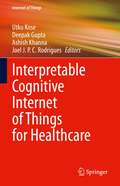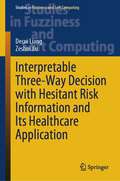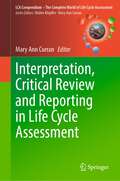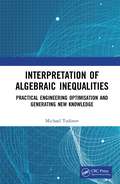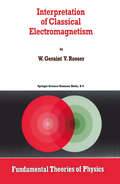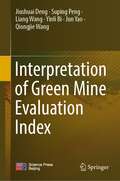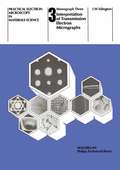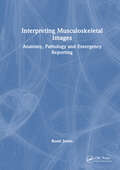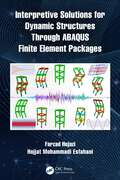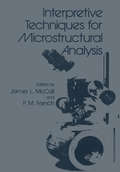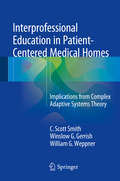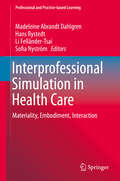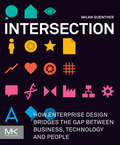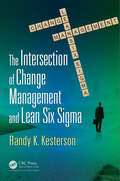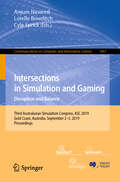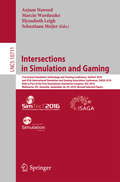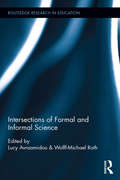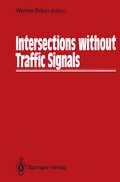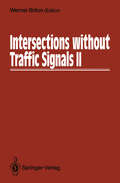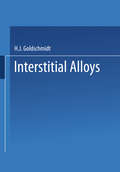- Table View
- List View
Interpretable Cognitive Internet of Things for Healthcare (Internet of Things)
by Utku Kose Deepak Gupta Ashish Khanna Joel J. P. C. RodriguesThis book presents research on how interpretable cognitive IoT can work to help with the massive amount of data in the healthcare industry. The authors give importance to IoT systems with intense machine learning features; this ensures the scope corresponds to use of cognitive IoT for understanding, reasoning, and learning from medical data. The authors discuss the interpretability of an intelligent system and its trustworthiness as a smart tool in the context of massive healthcare applications. As a whole, book combines three important topics: massive data, cognitive IoT, and interpretability. Topics include health data analytics for cognitive IoT, usability evaluation of cognitive IoT for healthcare, interpretable cognitive IoT for health robotics, and wearables in the context of IoT for healthcare. The book acts as a useful reference work for a wide audience including academicians, scientists, students, and professionals.
Interpretable Three-Way Decision with Hesitant Risk Information and Its Healthcare Application (Studies in Fuzziness and Soft Computing #431)
by Decui Liang Zeshui XuAs a new interpretable model, three-way decision has also received academic attention in machine learning. With respect to different hesitant fuzzy information, this book deeply discusses the deduction process of decision rules of three-way decision and generates interpretable knowledge with the risk semantics. It further explores the applications of three-way decision to support healthcare management. This book is used as a reference for engineers, technicians, and researchers who are working in the fields of management science, operation management, computer science, information management, fuzzy mathematics, business intelligence, and other fields. It also serves as a textbook for postgraduate and senior undergraduate students of the relevant professional institutions of higher learning.
Interpretation, Critical Review and Reporting in Life Cycle Assessment (LCA Compendium – The Complete World of Life Cycle Assessment)
by Mary Ann CurranThis book discusses the phase “Interpretation” in an outstanding way. According to the opinio communis within the LCA community, “Interpretation” is classified as fourth phase of the LCA framework. However, referring to ISO 14040, this book defines “Interpretation” according to its function in the LCA framework, and this means that “Interpretation has a much broader influence than generally accepted. It overarches goal and scope, inventory analysis and impact assessment. Conclusions are drawn from the results of the inventory and the impact assessment, and recommendations refer to the objective of the study, the goal and scope phase. Likewise to be considered are the defined framework conditions, the reasons for carrying out the study as well as the context of the intended applications and the target groups of the results). A second highlight of this book concerns “Interpretation” as discussed in conjunction with Critical Review and Reporting, which is an outstanding approach. The relationship between interpretation and critical review can be seen in the fact that interpretation is a kind of structured preparation of a critical review; in practice, the performance of a critical review can be made much easier if the preparers of a life cycle assessment study very carefully follow the requirements that are specifically placed on the interpretation. Because the critical review is the independent quality control of an LCA, the results improve the credibility of reporting. The critical review helps to avoid text weaknesses and potential misunderstandings because these aspects will easier be realized by independent readers from different viewpoints. The reviewers thus also represent the first readership of a study and can help to ensure that the specific requirements for good and clear reporting of life cycle assessments are met. Sound reporting needs clear conclusions.
Interpretation of Algebraic Inequalities: Practical Engineering Optimisation and Generating New Knowledge
by Michael TodinovThis book introduces a new method based on algebraic inequalities for optimising engineering systems and processes, with applications in mechanical engineering, materials science, electrical engineering, reliability engineering, risk management and operational research. This book shows that the application potential of algebraic inequalities in engineering and technology is far-reaching and certainly not restricted to specifying design constraints. Algebraic inequalities can handle deep uncertainty associated with design variables and control parameters. With the method presented in this book, powerful new knowledge about systems and processes can be generated through meaningful interpretation of algebraic inequalities. This book demonstrates how the generated knowledge can be put into practice through covering the algebraic inequalities suitable for interpretation in different contexts and describing how to apply this knowledge to enhance system and process performance. Depending on the specific interpretation, knowledge, applicable to different systems from different application domains, can be generated from the same algebraic inequality. Furthermore, an important class of algebraic inequalities has been introduced that can be used for optimising systems and processes in any area of science and technology provided that the variables and the separate terms of the inequalities are additive quantities. With the presented various examples and solutions, this book will be of interest to engineers, students and researchers in the field of optimisation, engineering design, reliability engineering, risk management and operational research.
Interpretation of Algebraic Inequalities: Practical Engineering Optimisation and Generating New Knowledge
by Michael TodinovThis book introduces a new method based on algebraic inequalities for optimising engineering systems and processes, with applications in mechanical engineering, materials science, electrical engineering, reliability engineering, risk management and operational research. This book shows that the application potential of algebraic inequalities in engineering and technology is far-reaching and certainly not restricted to specifying design constraints. Algebraic inequalities can handle deep uncertainty associated with design variables and control parameters. With the method presented in this book, powerful new knowledge about systems and processes can be generated through meaningful interpretation of algebraic inequalities. This book demonstrates how the generated knowledge can be put into practice through covering the algebraic inequalities suitable for interpretation in different contexts and describing how to apply this knowledge to enhance system and process performance. Depending on the specific interpretation, knowledge, applicable to different systems from different application domains, can be generated from the same algebraic inequality. Furthermore, an important class of algebraic inequalities has been introduced that can be used for optimising systems and processes in any area of science and technology provided that the variables and the separate terms of the inequalities are additive quantities. With the presented various examples and solutions, this book will be of interest to engineers, students and researchers in the field of optimisation, engineering design, reliability engineering, risk management and operational research.
Interpretation of Classical Electromagnetism (Fundamental Theories of Physics #78)
by G. RosserThe aim of this book is to interpret all the laws of classical electromagnetism in a modern coherent way. In a typical undergraduate course using vector analysis, the students finally end up with Maxwell's equations, when they are often exhausted after a very long course, in which full discussions are properly given of the full range of applications of individual laws, each of which is important in its own right. As a result, many students do not appreciate how limited is the experimental evidence on the basis of which Maxwell's equations are normally developed and they do not always appre ciate the underlying unity of classical electromagnetism, before they go on to graduate courses in which Maxwell's equations are taken as axiomatic. This book is designed to be used between such an undergraduate course and graduate courses. It is written by an experimental physicist and is intended to be used by physicists, electrical engineers and applied mathematicians.
Interpretation of Green Mine Evaluation Index
by Jiushuai Deng Suping Peng Liang Wang Yinli Bi Jun Yao Qiongjie WangThis book focuses on green mine evaluation. It includes green mine evaluation methods, evaluation content, evaluation indicators, etc. The "Green Mine Evaluation Index" has been issued by the Ministry of Natural Resources of China. In order to promote mining enterprises, green mine consulting service agencies, third-party evaluation agencies and mining administration personnel to better understand and practice the provisions of green mine evaluation indicators, the authors wrote this "Interpretation of Green Mine Evaluation Index". The content of this book specifically includes introduction, prerequisites for green mine selection, score sheet of green mine construction, related knowledge, as well as introduction of specific green mine evaluation items, including mining area environment, resource development methods, comprehensive utilization of ore resources, energy saving and emission reduction, technological innovation and smart mines, corporate management and corporate image, etc. The relevant concepts, relevant laws and policies, implementation measures, inspection points, and materials that enterprises should provide, have been vividly expounded based on the actual situation and specific cases of green mine construction. This book is useful as a reference for managers, engineering and technical personnels, teachers and students from mining enterprises, government departments, consulting services and evaluation agencies, colleges and secondary professional schools.
Interpreting Musculoskeletal Images: Anatomy, Pathology and Emergency Reporting
by Rosie JonesThis visual manual is an accessible guide to musculoskeletal image interpretation and reporting, including common trauma pathologies, arthropathies, mechanisms of injury and classification systems. Beautifully illustrated with schematic line diagrams, supplemented with radiographs and scans, the content has been developed to enhance learning and understanding of both radiology and anatomy, and the relationship between them.Key features: Concise, yet highly informative Large, high-quality illustrations supplement and enhance the written descriptions, with colour-coding for rapid matching of image to corresponding text Relates imaging to underlying anatomy and pathology, aiding accurate interpretation Carefully designed to support rapid access in the clinical setting and ideal also as a revision aid during examination preparation The book delivers hands-on support to junior doctors, other emergency medicine personnel and practising radiographers for use in the clinical setting and is also ideal for students preparing for qualifying examinations in medicine and radiography.
Interpreting Musculoskeletal Images: Anatomy, Pathology and Emergency Reporting
by Rosie JonesThis visual manual is an accessible guide to musculoskeletal image interpretation and reporting, including common trauma pathologies, arthropathies, mechanisms of injury and classification systems. Beautifully illustrated with schematic line diagrams, supplemented with radiographs and scans, the content has been developed to enhance learning and understanding of both radiology and anatomy, and the relationship between them.Key features: Concise, yet highly informative Large, high-quality illustrations supplement and enhance the written descriptions, with colour-coding for rapid matching of image to corresponding text Relates imaging to underlying anatomy and pathology, aiding accurate interpretation Carefully designed to support rapid access in the clinical setting and ideal also as a revision aid during examination preparation The book delivers hands-on support to junior doctors, other emergency medicine personnel and practising radiographers for use in the clinical setting and is also ideal for students preparing for qualifying examinations in medicine and radiography.
Interpretive Solutions for Dynamic Structures Through ABAQUS Finite Element Packages
by Farzad Hejazi Hojjat Mohammadi EsfahaniABAQUS software is a general-purpose finite element simulation package mainly used for numerically solving a wide variety of design engineering problems; however, its application to simulate the dynamic structures within the civil engineering domain is highly complicated. Therefore, this book aims to present specific complicated and puzzling challenges encountered in the application of Finite Element Method (FEM) for solving the problems related to Structural Dynamics using ABAQUS software that can fully utilize this method in complex simulation and analysis. Various chapters of this book demonstrate the process for the modeling and analysis of impenetrable problems through simplified step-by-step illustration by presenting screenshots from ABAQUS software in each part/step and showing various graphs. Highlights: Focuses on solving problems related to Structural Dynamics using ABAQUS software Helps to model and analyze the different types of structures under various dynamic and cyclic loads Discusses the simulation of irregularly-shaped objects comprising several different materials with multipart boundary conditions Includes the application of various load effects to develop structural models using ABAQUS software Covers a broad array of applications such as bridges, offshores, dams, and seismic resistant systems Overall, this book is aimed at graduate students, researchers, and professionals in structural engineering, solid mechanics, and civil engineering.
Interpretive Solutions for Dynamic Structures Through ABAQUS Finite Element Packages
by Farzad Hejazi Hojjat Mohammadi EsfahaniABAQUS software is a general-purpose finite element simulation package mainly used for numerically solving a wide variety of design engineering problems; however, its application to simulate the dynamic structures within the civil engineering domain is highly complicated. Therefore, this book aims to present specific complicated and puzzling challenges encountered in the application of Finite Element Method (FEM) for solving the problems related to Structural Dynamics using ABAQUS software that can fully utilize this method in complex simulation and analysis. Various chapters of this book demonstrate the process for the modeling and analysis of impenetrable problems through simplified step-by-step illustration by presenting screenshots from ABAQUS software in each part/step and showing various graphs. Highlights: Focuses on solving problems related to Structural Dynamics using ABAQUS software Helps to model and analyze the different types of structures under various dynamic and cyclic loads Discusses the simulation of irregularly-shaped objects comprising several different materials with multipart boundary conditions Includes the application of various load effects to develop structural models using ABAQUS software Covers a broad array of applications such as bridges, offshores, dams, and seismic resistant systems Overall, this book is aimed at graduate students, researchers, and professionals in structural engineering, solid mechanics, and civil engineering.
Interpretive Techniques for Microstructural Analysis
by J. McCallIn recent years microstructural analysis has been a rapidly changing field of scien tific endeavor. No longer are the efforts of the microstructural analysts (sometimes referred to as metallographers, materialographers, ceramographers, and similar desig nations) limited to the tasks of polishing, etching, and photographing specimens of materials. The performance demanded of materials used for many current applica tions requires much more complete characterizations than were possible only a scant few years ago. Although the individuals who have been expected to develop new and improved techniques to permit these required characterizations have been severely challenged, in large part they have met the challenge. In view of the many new developments in the field of microstructural analysis and recognizing the requirements to communicate these developments to the wide audience that might make use of them, the American Society for Metals and the In ternational Metallographic Society joined forces to co-sponsor a symposium that was intended to bring participants and attendees up to date on the subject "Inter pretive Techniques for Microstructural Analysis". This symposium was held in Min neapolis, Minnesota, USA, June 29 and 30, 1975. It followed two earlier symposia co-sponsored by the same two societies on other subjects of current interest to the metallographic community, Microstructural Analysis - Tools and Techniques, 1972, and Metallographic Specimen Preparation - Optical and Electron Micros copy, 1973.
Interprofessional Education in Patient-Centered Medical Homes: Implications from Complex Adaptive Systems Theory
by C. Scott Smith Winslow G. Gerrish William G. WeppnerThis book discusses the application of complex adaptive systems theory to the design and evaluation of patient-centered medical homes (PCMHs). The three defining goals of PCMHs are to spread patient-care roles among healthcare team members, focus on disease prevention and include the patient in the healthcare team. It explains why some PCMH pilots are highly successful while others do not show much benefit, covers specific sub-theories that allow for bracketing of different aspects of the clinic system and highlights strategies by which institutions can engage in this process. Inter professional Education in Patient-Centered Medical Homes is a valuable resource for faculty and managers of health professions teaching clinics, deans of medical and health professional schools and medical administrators.
Interprofessional Simulation in Health Care: Materiality, Embodiment, Interaction (Professional and Practice-based Learning #26)
by Madeleine Abrandt Dahlgren Hans Rystedt Li Felländer-Tsai Sofia NyströmThis book describes and discusses a practice-oriented approach to understanding and researching interprofessional simulation-based education and simulation. It provides empirical findings from research on this topic and is informed by practice-oriented perspectives. It identifies critical features of the simulation practice and discusses how these can be used in reforming simulation pedagogy. The book is divided into three sections. Section 1 sets the scene for understanding the practices of interprofessional simulation-based education and simulation. It provides a theoretical and methodological framework for the conceptualisation of practices and for the empirical studies on which the book is based. Section 2 revisits the dimensions of the simulation process/exercise, i.e. the briefing, simulation, and debriefing, and provides empirical analyses of how the practice of simulation unfolds. Based on these analyses, section 3 identifies and discusses how pedagogies for simulation can be reformed to meet the demands of future healthcare and research.
Intersection: How Enterprise Design Bridges the Gap between Business, Technology, and People
by Milan GuentherMany organizations struggle with the dynamics and the complexity of today's social ecosystems that connect everyone and everything, everywhere and all the time. Facing challenges at the intersection of business models, technical developments, and human needs, modern enterprises must overcome the siloed thinking and isolated efforts of the past, and instead address their relationships to people holistically. In Intersection, Milan Guenther introduces a Strategic Design approach that aligns the overarching efforts of Branding, Enterprise Architecture, and Experience Design, and sets them on a common course to shape tomorrow’s enterprises. This book gives designers, entrepreneurs, innovators, and leaders a model and a comprehensive vocabulary for tackling such deep-rooted challenges. The Enterprise Design framework cuts through the complexity of Strategic Design work, showing how to navigate key aspects and bridge diverging viewpoints. In 9 case studies, the author looks at the way companies like SAP, BBVA, IKEA, and Jeppesen (a Boeing Company) apply design thinking and practice to shape their enterprises. Moving from strategy to conceptual design and concrete results, Intersection shows what is relevant at which point, and what expertise to involve.Teaches how to align business strategy with Brand Identity, Customer Experience, and Enterprise Architecture initiatives as part of a consolidated enterprise-wide design practice to achieve stakeholder value Provides a framework for designing systems, products and services as the building blocks of a consistent and coherent experience for all stakeholders in the wider enterprise, joining strategic considerations with the delivery of tangible outcomes Explains how to make results such as websites, apps, objects, platforms, or environments part of a larger system that orchestrates enterprise touchpoints with people
The Intersection of Change Management and Lean Six Sigma: The Basics for Black Belts and Change Agents
by Randy K. Kesterson"Randy has crafted an invaluable book, no matter where you are in the journey of organizational change management. A must-have guide you will refer to again and again." – Marshall Goldsmith, author of the #1 New York Times bestseller, Triggers. "Randy Kesterson recognizes that much of the energy that organizations put into Lean and Six Sigma improvements is wasted when the results are not applied effectively due to the organization’s resistance to change." – Ellen Domb, Ph.D. PQR, one of the world’s top 50 quality experts at QualityGurus.com "Finally, a book that recognizes that most organizations are on the left side of the FAT–LEAN continuum. Far too many organizations think they are Lean/Six Sigma mature only to realize that they aren’t even close." – Gerhard Plenert, Ph.D., serves as Director of Executive Education, Shingo Institute, Home of the Shingo Prize The Intersection of Change Management and Lean Six Sigma: The Basics for Black Belts and Change Agents is for Lean and Six Sigma professionals working inside organizations with low Lean maturity and significant resistance to change. Written by a business executive and certified Lean Six Sigma black belt, this book: Provides sound, innovative practices for those interested in successfully navigating organizational change. Focuses on culture change and mindsets, not just tools and applications. Stresses effective communication ensuring that various stakeholders understand the reasons for the change, the benefits, and the details. Illustrates how the benefits of Lean and Six Sigma initiatives can benefit the change management process. This book pinpoints and examines the intersection of change management and Lean Six Sigma. It features interviews with change management practitioners (executives, project managers, and black belts) and provides pertinent case studies detailing successful and failed changes.
The Intersection of Change Management and Lean Six Sigma: The Basics for Black Belts and Change Agents
by Randy K. Kesterson"Randy has crafted an invaluable book, no matter where you are in the journey of organizational change management. A must-have guide you will refer to again and again." – Marshall Goldsmith, author of the #1 New York Times bestseller, Triggers. "Randy Kesterson recognizes that much of the energy that organizations put into Lean and Six Sigma improvements is wasted when the results are not applied effectively due to the organization’s resistance to change." – Ellen Domb, Ph.D. PQR, one of the world’s top 50 quality experts at QualityGurus.com "Finally, a book that recognizes that most organizations are on the left side of the FAT–LEAN continuum. Far too many organizations think they are Lean/Six Sigma mature only to realize that they aren’t even close." – Gerhard Plenert, Ph.D., serves as Director of Executive Education, Shingo Institute, Home of the Shingo Prize The Intersection of Change Management and Lean Six Sigma: The Basics for Black Belts and Change Agents is for Lean and Six Sigma professionals working inside organizations with low Lean maturity and significant resistance to change. Written by a business executive and certified Lean Six Sigma black belt, this book: Provides sound, innovative practices for those interested in successfully navigating organizational change. Focuses on culture change and mindsets, not just tools and applications. Stresses effective communication ensuring that various stakeholders understand the reasons for the change, the benefits, and the details. Illustrates how the benefits of Lean and Six Sigma initiatives can benefit the change management process. This book pinpoints and examines the intersection of change management and Lean Six Sigma. It features interviews with change management practitioners (executives, project managers, and black belts) and provides pertinent case studies detailing successful and failed changes.
Intersections in Simulation and Gaming: Third Australasian Simulation Congress, ASC 2019, Gold Coast, Australia, September 2–5, 2019, Proceedings (Communications in Computer and Information Science #1067)
by Anjum Naweed Lorelle Bowditch Cyle SprickThis book constitutes the refereed proceedings of the Australasian Simulation Congress, ASC 2019, held in Gold Coast, Australia in September 2019. The 10 papers presented were carefully reviewed and selected from 17 submissions. They provide a forum for sharing progresses in the areas of human dimensions; gaming experience; design and application; search and rescue; defence-oriented technology and training.
Intersections in Simulation and Gaming: 21st Annual Simulation Technology and Training Conference, SimTecT 2016, and 47th International Simulation and Gaming Association Conference, ISAGA 2016, Held as Part of the First Australasian Simulation Congress, ASC 2016, Melbourne, VIC, Australia, September 26-29, 2016, Revised Selected Papers (Lecture Notes in Computer Science #10711)
by Anjum Naweed Marcin Wardaszko Elyssebeth Leigh Sebastiaan MeijerThis book constitutes the refereed post-conference proceedings of the 21st Annual Simulation Technology and Training Conference, SimTecT 2016, and the 47th International Simulation and Gaming Association Conference, ISAGA 2016, Held as Part of the First Australasian Simulation Congress, ASC 2016, held in Melbourne, VIC, Australia, in September 2016. The 28 revised full papers included in the volume were carefully reviewed and selected from 55 submissions. They are organized in the following topical sections: Making the grade; Come to think of it; From here to fidelity; The name of the game; and Ahead of the game.
Intersections of Formal and Informal Science (Routledge Research in Education)
by Wolff-Michael Roth Lucy AvraamidouScience learning that takes place between and at the intersections of formal and informal science environments has not been systematically reviewed to offer a comprehensive understanding of the existing knowledge base. Bringing together theory and research, this volume describes the various ways in which learning science in various settings has been conceptualized as well as empirical evidence to illustrate how science learning in these settings can be supported.
Intersections of Formal and Informal Science (Routledge Research in Education #165)
by Wolff-Michael Roth Lucy AvraamidouScience learning that takes place between and at the intersections of formal and informal science environments has not been systematically reviewed to offer a comprehensive understanding of the existing knowledge base. Bringing together theory and research, this volume describes the various ways in which learning science in various settings has been conceptualized as well as empirical evidence to illustrate how science learning in these settings can be supported.
Intersections without Traffic Signals: Proceedings of an International Workshop, 16–18 March, 1988 in Bochum, West Germany
From March 16 - 18, 1988, an international workshop on inter sections without traffic signals will take place at the Ruhr University, Bochum. This book, which was compiled prior to the event, comprises the written versions of the contributions pre sented at the workshop. This preface is an attempt to give a short survey of the deve lopment of this particular field of traffic engineering. It has to be said in advance, however, that it is written from a point of view decisively influenced by the relevant German litera ture. Most of the intersections in our road networks are unsignaliz ed. At first glance, however, traffic engineers seem to be more interested in high-performance grade-separated or signalized intersections. But a closer study of the relevant literature does not confirm this apparent lack of importance. On the contrary: The subject of unsignalized intersections is still intensively dealt with at many research institutes. The German observer will notice the following fact while study ing the relevant sources: A remarkably high number of the au thors who have contributed to the investigation of unsignalized intersections in German-speaking countries have later become uni versi ty teachers. There is every reason to believe that traffic engineers primarily interested in theoretical problems have mainly been working in this field.
Intersections without Traffic Signals II: Proceedings of an International Workshop, 18–19 July, 1991 in Bochum, Germany
by Werner BrilonIn March 1988, an international workshop on intersections without traffic signals was held at the Ruhr-University in Bochum, Germany. The proceedings of this workshop were published by Springer 1). The workshop was performed in a very harmonious atmosphere, which stimulated the experts from different countries to communicate and exchange their ideas and experiences. The presentations and the written contributions documented the present state of technical solutions for design and engineering of unsi gnalized intersections both regarding scientific research and practical applications. Moreover, numerous unsolved problems were identified. Thus, the 1988 workshop stimulated new developments in the field of unsignalized inter sections in several countries. In the meantime, these investigations have lead to a remarkable progress. For example in Germany a new guideline for unsignalized cross intersections and T-junctions has been finished and is going to be introduced in 1991. New results on roundabout capacity have been worked out as well. Many particularly important developments were made in foreign countries. Especially in the United States, an increasing interest in this subject can be observed. In the annual meetings of the TRB, this item received great attention. Many research institutes in North America have concentrated their activities on that point. A new TRB-circular concerning unsignalized intersections is going to be published. It will contain a new procedure for four-way-stop-control intersections, which seems to be a special feature of North American traffic engineering. However, new results from the US for two-way-stop control intersections are available as well.
